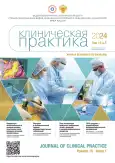Синдром транзиторного идиопатического периваскулярного воспаления каротидной артерии (TIPIC-синдром) — редкий вариант неатеросклеротической артериопатии
- Авторы: Белопасова А.В.1, Мигляченко П.С.2, Чечеткин А.О.1, Древаль М.В.1, Добрынина Л.А.1
-
Учреждения:
- Научный центр неврологии, Москва
- Московский государственный университет имени М.В. Ломоносова
- Выпуск: Том 15, № 1 (2024)
- Страницы: 120-128
- Раздел: Клинические случаи
- URL: https://journal-vniispk.ru/clinpractice/article/view/257946
- DOI: https://doi.org/10.17816/clinpract625468
- ID: 257946
Цитировать
Полный текст
Аннотация
Обоснование. Транзиторное идиопатическое периваскулярное воспаление каротидной артерии (Transient Idiopathic Perivascular Inflammation of the Carotid artery, TIPIC), или каротидиния, — клинико-радиологический синдром, проявляющийся односторонней болью в области шеи и наличием ипсилатерального периваскулярного инфильтрата по данным ультразвуковой и магнитно-резонансной визуализации. В связи с низкой осведомлённостью врачей патология нередко ошибочно расценивается как диссекция или атеросклероз сонной артерии, что приводит к дополнительной диагностике и неоправданному лечению.
Описание клинического случая. Представлен клинический случай идиопатической каротидинии у женщины в возрасте 40 лет с обсуждением алгоритма диагностики и тактики ведения пациента с односторонней болью в области шеи.
Заключение. Своевременно проведённая и грамотно интерпретированная ангиовизуализация является ключевым звеном в диагностике каротидинии. Благоприятное течение, полный регресс симптоматики и патологических изменений в артерии без специфической терапии относят её к доброкачественным вариантам неатеросклеротических артериопатий.
Полный текст
Открыть статью на сайте журналаОб авторах
Анастасия Владимировна Белопасова
Научный центр неврологии, Москва
Автор, ответственный за переписку.
Email: belopasova@neurology.ru
ORCID iD: 0000-0003-3124-2443
SPIN-код: 3149-3053
канд. мед. наук, ст. науч. сотр.
Россия, МоскваПолина Сергеевна Мигляченко
Московский государственный университет имени М.В. Ломоносова
Email: miglyachencko.polina@yandex.ru
ORCID iD: 0009-0005-8751-9327
Россия, Москва
Андрей Олегович Чечеткин
Научный центр неврологии, Москва
Email: chechetkin@neurology.ru
ORCID iD: 0000-0002-8726-8928
SPIN-код: 9394-6995
д-р мед. наук
Россия, МоскваМарина Владимировна Древаль
Научный центр неврологии, Москва
Email: dreval.mv@neurology.ru
ORCID iD: 0000-0002-7554-9052
SPIN-код: 2221-9226
канд. мед. наук, науч. сотр.
Россия, МоскваЛариса Анатольевна Добрынина
Научный центр неврологии, Москва
Email: dobrynina@neurology.ru
ORCID iD: 0000-0001-9929-2725
SPIN-код: 2824-8750
д-р мед. наук
Россия, МоскваСписок литературы
- Caplan LR, Biller J. Non-atherosclerotic vasculopathies. In: Caplan L.R., ed. Caplan’s stroke: a clinical approach. Cambridge University Press; 2016. Р. 386–438.
- Agarwal A, Bathla G, Kanekar S. Imaging of Non-atherosclerotic Vasculopathies. J Clin Imaging Sci. 2020;10:62. doi: 10.25259/JCIS_91_2020
- Simma B, Martin G, Müller T, Huemer M. Risk factors for pediatric stroke: Consequences for therapy and quality of life. Pediatr Neurol. 2007;37(2):121–126. doi: 10.1016/j.pediatrneurol.2007.04.005
- Fay T. Atypical neuralgia. Arch Neurol Psychiatry. 1927;18:309–315.
- Classification and diagnostic criteria for headache disorders, cranial neuralgias and facial pain. Headache Classification Committee of the International Headache Society. Cephalalgia. 1988;8 Suppl 7:1-96. PMID: 3048700.
- Headache Classification Subcommittee of the International Headache Society. The International Classification of Headache Disorders: 2nd edition. Cephalalgia. 2004;24(Suppl 1):9–160. doi: 10.1111/j.1468-2982.2003.00824.x
- Lecler A, Obadia M, Savatovsky J, et al. TIPIC syndrome: Beyond the myth of carotidynia, a new distinct unclassified entity. AJNR Am J Neuroradiol. 2017;38(7):1391–1398. doi: 10.3174/ajnr.A5214
- Lecler A, Obadia M, Sadik JC. Introduction of the TIPIC syndrome in the next ICHD classification. Cephalalgia. 2019;39(1):164–165. doi: 10.1177/0333102418780485
- Hayashi S, Maruoka S, Takahashi N, Hashimoto S. Carotidynia after anticancer chemotherapy. Singapore Med J. 2014;55(9):e142–144. doi: 10.11622/smedj.2014127
- Corral de la Fuente E, Barquín Garcia A, Saavedra Serrano C, et al. Myocarditis and carotidynia caused by Granulocyte-Colony stimulating factor administration. Mod Rheumatol Case Rep. 2020;4(2):318–323. doi: 10.1080/24725625.2020.1754552
- Jabre MG, Shahidi GA, Bejjani BP. Probable fluoxetine-induced carotidynia. Lancet. 2009;374(9695):1061–1062. doi: 10.1016/S0140-6736(09)61694-9
- Venetis E, Konopnicki D, Jissendi Tchofo P. Multimodal imaging features of transient perivascular inflammation of the carotid artery (TIPIC) syndrome in a patient with Covid-19. Radiol Case Rep. 2022;17(3):902–906. doi: 10.1016/j.radcr.2021.12.005
- Upton PD, Smith JG, Charnock DR. Histologic confirmation of carotidynia. Otolaryngol Head Neck Surg. 2003;129(4):443–444. doi: 10.1016/S0194-59980300611-9
- Калашникова Л.А., Добрынина Л.А. Диссекция артерий головного мозга: ишемический инсульт и другие клинические проявления. Москва, 2013. 208 с. [Kalashnikova LA, Dobrynina LA. Cervical artery dissection: Ischemic stroke and other clinical manifestations. Moscow; 2013. 208 p. (In Russ).]
- Stanbro M, Gray BH, Kellicut DC. Carotidynia: Revisiting an unfamiliar entity. Ann Vasc Surg. 2011;25(8):1144–1153. doi: 10.1016/j.avsg.2011.06.006
- Taniguchi Y, Horino T, Hashimoto K. Is carotidynia syndrome a subset of vasculitis? J Rheumatol. 2008;35(9):1901–1902.
- Taniguchi Y, Horino T, Terada Y, Jinnouchi Y. The activity of carotidynia syndrome is correlated with the soluble intracellular adhesion molecule-1 (sICAM-1) level. South Med J. 2010;103(3):277–278. doi: 10.1097/SMJ.0b013e3181cf39e2
- Abrahamy M, Werner M, Gottlieb P, Strauss S. Ultrasound for the diagnosis of carotidynia. J Ultrasound Med. 2017;36(12): 2605–2609. doi: 10.1002/jum.14321
- Ulus S, Aksoy Ozcan U, Arslan A, et al. Imaging spectrum of TIPIC syndrome. Clin Neuroradiol. 2018;18(Suppl 7):1–13. doi: 10.1007/s00062-018-0746-5
- Amaravadi RR, Behr SC, Kousoubris PD, Raja S. [18F] Fluorodeoxyglucose positron-emission tomography-CT imaging of carotidynia. AJNR Am J Neuroradiol. 2008;29(6):1197–1199. doi: 10.3174/ajnr.A1013
- Comacchio F, Bottin R, Brescia G, et al. Carotidynia: new aspects of a controversial entity. Acta Otorhinolaryngol Ital. 2012;32:266.
- Mathangasinghe Y, Karunarathne RU, Liyanage UA. Transient perivascular inflammation of the carotid artery; a rare cause of intense neck pain. BJR Case Rep. 2019;5(4):20190014. doi: 10.1259/bjrcr.20190014
- Sato S, Yazawa Y, Itabashi R, et al. [A case of carotidynia with carotid sinus hypersensitivity. (In Japan)]. Rinsho Shinkeigaku. 2010;50(10):714–717. doi: 10.5692/clinicalneurol.50.714
- Schaumberg J, Michels P, Eckert B, Röther J. [Recurrence of carotodynia or TIPIC syndrome. (In German)]. Nervenarzt. 2018;89(12):1403–1407. doi: 10.1007/s00115-018-0531-3
Дополнительные файлы











